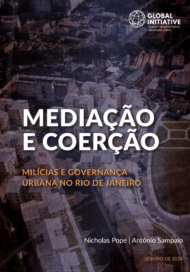Posted on 04 Jan 2024
Militia involvement in the land and real estate sector is widespread across the city and metropolitan region of Rio de Janeiro. This report shows that the poorly regulated real estate and property market served as a driver of militias’ expansion in Rio by allowing them to exploit economic and political opportunities amid underserviced urban areas. The paper analyses how the governance of urban expansion has enabled these networks to embed themselves into the political, economic and social structures and institutions of the city.
In 2009, President Luiz Inácio Lula da Silva launched one of the most ambitious housing projects in Brazil’s history: Minha Casa, Minha Vida (My House, My Life). It became one of the signature social development policies of Lula’s Workers’ Party and is now being relaunched in his return to presidency for a third term. With over four million houses built in the first decade of the programme, it tackled the longstanding housing shortfalls that contributed to the spread of the country’s vast informal settlements in and around cities (including the hillside informal favelas) and offered politicians convenient media photography opportunities with new homeowners. Even Lula’s fierce political rival, former President Jair Bolsonaro, continued the policy, although with severe budget cuts in 2021.
It quickly became clear that newly built homes – which some low-income Brazilians saw as an opportunity to leave structurally unsafe houses or insecure urban areas – would not offer respite from encroaching criminal actors operating in the profitable housing market. Homeowners from the programme lived in fear of criminal organizations, with many facing the threat of violence, firearms and expulsion from their newly acquired homes.
An article in one newspaper, Extra, cited 674 reports indicating the presence of organized criminal groups in Minha Casa, Minha Vida communities across 19 municipalities in Rio de Janeiro (including the eponymous capital). One police operation in May 2018 saw officers seize eight guns, including a 9 millimetre submachine gun. It was found in a flat in a residential complex built under the government’s programme in Itaguaí, a municipality north-west of Rio. The operation responded to intelligence about the location of a weapons cache belonging to the local militia: an armed group usually comprising large numbers of off-duty or former members of the local security forces (especially the military police) operating in several criminal markets. Coercive control and de facto governance of peripheral urban communities enable militias to dominate several markets such as transportation, water, electricity, cooking gas, microloans, internet, cable television and security.
These services are often provided in full view (or with the plausible deniability) of state officials and enforcement agencies. This highlights a key difference between militias and Rio de Janeiro’s infamous drug gangs: militias are often facilitated by overlapping interests and entanglements with powerful state, political and business actors in formal and legal positions, while drug gangs tend to operate in relative isolation from formal institutions and with a narrower focus on drugs markets.
Militias have been involved in constructing new buildings and entire residential areas within some of the urban regions furthest from Rio’s city centre – many in what is known as the West Zone. Ambitious residential projects, including high rises, experienced a fivefold increase between 2016 and 2020. Some Brazilian scholars have referred to this as a ‘capillarization’ of militia projects, representing an ‘unprecedented phenomenon’ in Brazilian urban centres. This is due to the extensive territorial area, the range of criminal markets involved and militia infiltration of public administration.
This report examines how militias’ core function derives from their ability to broker solutions in response to the collective action problems created by rapid and unfettered urbanization. Militias mediate between states, residents and markets to deal with infrastructural and service inadequacies, which have historically proved severe in Brazilian cities. Through these functions, militias build up social, political and economic capital and expand their influence. Militias’ growing dominance – in line with the expansion of the city – has also led to rising levels of violence. Up to 70% of femicides in Rio de Janeiro take place in the militia-dominated West Zone, with 34.5% of the metropolitan region’s shootouts and 23.85% of disappearances occurring in this region.
This report demonstrates how the poorly regulated real estate and property market stimulates militia expansion in Rio de Janeiro by enabling them to exploit economic and political opportunities in underserviced urban areas. Plotting the history of militias’ involvement in land seizures, construction and real estate markets, it analyzes how urban expansion governance has enabled these networks to embed themselves within the city’s political and economic social structures and institutions. This has affected other sectors and markets, such as the extraction of sand from rivers, as well as the informal division of land for sale to residents or developers.





